Perhaps Rockville Pike's mobility solution is a "transit mall," not BRT | Introducing the PikeRide concept
Wisconsin Avenue/Rockville Pike in Montgomery County Maryland is a classic example of a traffic engorged suburban arterial.
I frequently use this Washington Post photo to illustrate the problem. The street is lined by all types of uses including office buildings and residences, but is best known for its many shopping centers and retail stores, most with parking in front.
Most of the lots are not interconnected, so people hop and skip by car along the Pike to accomplish their trips, making many separate little trips along the way.
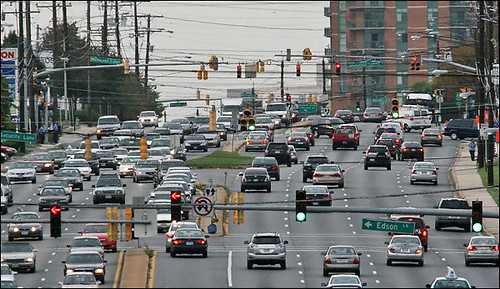
Rockville Pike, looking north, which Montgomery planners want to transform into a network of urban villages. Washington Post photo by Bill O'Leary.
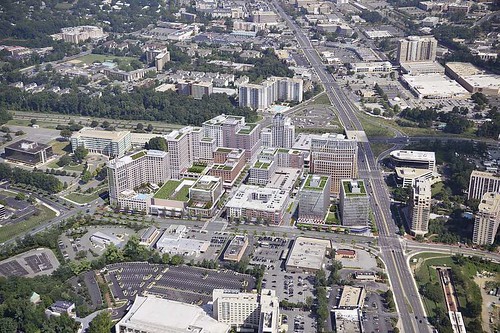
About ten years ago, developers and planners worked out a land use repatterning in the "North Bethesda/White Flint" area, aiming to move from superblocks and parking-fronted shopping centers to smaller blocks, a more robust street grid, buildings at the streetfront with structured parking, and mixed use developments including a fair amount of housing, along with a rebuilt street and streetscape that serves multiple modes and doesn't focus strictly on automobility.
-- Friends of White Flint
From a "smart growth"/new urbanism perspective, this is one of the more interesting attempts at "urbanizing" suburbia anywhere in the US ("Makeover Seeks to Tame Rockville Pike in Maryland," New York Times, 2010). Currently, the Pike & Rose redevelopment on the site of a previously existing parking-fronted shopping center is the foremost example of this new paradigm.
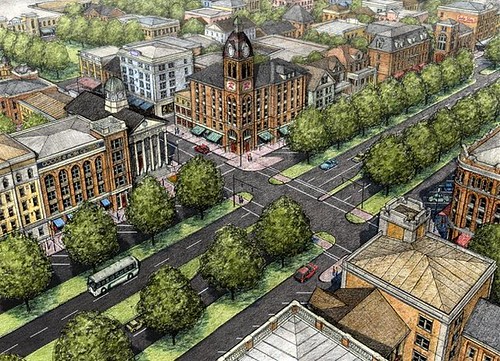
Transforming Rockville Pike, Montgomery's commercial spine, into a tree-lined boulevard, with more open space and greenery, is a priority of Montgomery County planners. Although political leaders and residents support the change, obstacles such as cost remain. The redesign will allow residents to work, dine and shop within blocks of their high-rise apartments in an ultra-urban setting, to stitch residential and retail areas together. Image: Maryland-National Capital Park and Planning Commission.
The corridor is served by four Metrorail transit stations--Grosvenor (which serves the Strathmore Music Center), White Flint, Twinbrook, and Rockville, over a 4.6 mile distance--and there are proposals to add a MARC commuter rail station to the White Flint/now called "Pike District" area, to complement the existing MARC station at Rockville.
The White Flint initiative to repattern the sub/urban design, streetscape, mobility, and placemaking qualities of the district has a twin in the Rockville Town Center program (article from Terrain), in the core of the city near the Metrorail station. One of the anchors of the development is a county library and adjacent arts center, and a well used and programmed public square.

Bus rapid transit on Rockville Pike. Separately, Montgomery County's Department of Transportation is moving a bus rapid transit program forward. Rockville Pike is one of the proposed corridors and will be a key element of the network.
Last year, the department's RideOn bus system introduced a limited stop bus service along the Pike, called RideOn Extra, to provide a faster ride over longer distance trips.
But I have written pieces in the past criticizing how BRT has been promoted for Rockville Pike, making the point that videos promoting the concept laid out the service as being able to serve families making multiple stops over relatively short distances ("schlepping multiple kids, stroller and packages on and off the bus"), between destinations along the Pike--mostly various shopping centers, but also housing, supermarkets, etc.
Taking an "intra-district" approach to transit mobility. BRT service as conceptualized is about fast transit making a relatively few number of stops over long distances. It's a form of express bus service. But on Rockville Pike, there are probably 3-8 significant destinations per mile counting both sides of the street, so it isn't well suited to limited stop service.
Separately I have tried to come to grips with differentiating "circulator" and streetcar programs from the standpoint of "intra-district" versus inter-district transit service.
-- "Modern streetcars are transportation projects, not merely economic development augurs: but intra-district not inter-city services," 2017
In other words getting around within a concentrated area of a destination versus getting to and from that concentrated area from multiple points in a metropolitan area. (Unfortunately, a lot of commentary mixes up the two purposes.)
Examples of intra-district service include bus circulators, streetcars, and "people movers."
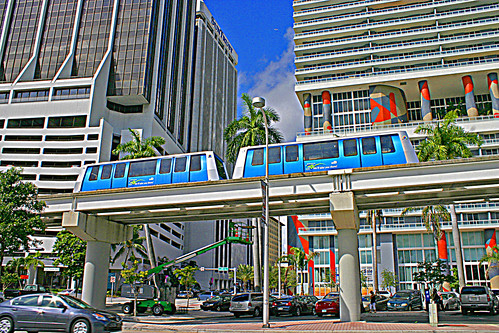
Miami People Mover.
Travel to Downtown Washington and Downtown Baltimore are good examples of this. In both places, the respective city has created core-focused "circulator" bus programs to move people around within the core, which the inter-jurisdictional bus routes and subway lines bringing people to the district aren't set up to do.
Transit malls. In other cities, a variant of this kind of service is provided by creating a bus or transit mall to concentrate the routes and services. Nicollet Mall in Minneapolis and the 16th Street Mall in Denver are the foremost examples.
In Minneapolis, the Nicollet Mall is served by multiple bus lines but also has a free intra-district transit bus. In Denver, 16th Street Mall is a pedestrian and transit mall, with the primary transit service being the free MallRide buses.

Denver MallRide. Transportation for America photo.
Why not treat Rockville Pike as a "transit mall" and create a PikeRide bus service to support intra-district trips. Granted the distance between Grosvenor and Rockville Metrorail stations is 4.6 miles, and Denver's 16th Street Mall is 1.25 miles, but the way to reduce intra-district traffic may be to adopt the circulator/Denver MallRide concept separate from BRT, which has a different purpose.
You could call it PikeRide, although that's what they call bus service on Columbia Pike in Arlington County, Virginia. The (Rockville)PikeRide would be a free circulator, just like the Denver MallRide.
Elsewhere in Montgomery County the county supports similar kinds of services. The County supports a free circulator bus in Silver Spring, and the Bethesda Urban Partnership business improvement district supports a free circulator bus there.
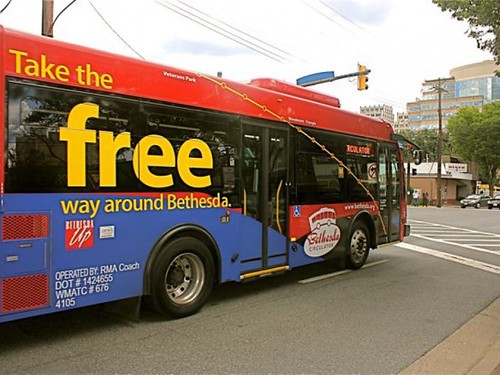
Free Bethesda Circulator Bus.
Arlington County's Columbia Pike bus network as a model. The transit network concept for Columbia Pike is similar to what I am proposing for Rockville Pike. There they have three levels of service--limited stop (like the new RideOn Extra); regular service with more stops, but fewer stops than the local service, which stops at many more locations along the corridor. Except that (Rockville)PikeRide would be free, and the Columbia PikeRide service is not.
This WMATA map of the PikeRide transit network shows how the different bus lines combine to provide high frequency service in the core of the Columbia Pike corridor.
That's the basic idea for the Rockville Pike concept, but focusing on the development of an intra-district bus service through a dedicated circulator, which would also complement the Metrorail stations, which aren't so great at supporting trips within the district, as opposed to trips getting to and from the district.
Complementing transit service with package delivery? I still can't get over that video promoting BRT on Rockville Pike.
Even with a free hop on/hop off bus service--and figure that the highest use would be between the White Flint mall and Metrorail area and somewhere between Twinbrook and Rockville Metrorail stations--carrying lots of packages on and off buses is likely to be inconvenient.
 Separately, a delivery service could be created, where people who spend a certain amount can get the packages delivered to home--figuring this would be offered within a couple miles distance on either side of the Pike. (As an example, the area's Megamart Latino supermarket chain offers a free trip home to customers so long as they purchase at least $50.)
Separately, a delivery service could be created, where people who spend a certain amount can get the packages delivered to home--figuring this would be offered within a couple miles distance on either side of the Pike. (As an example, the area's Megamart Latino supermarket chain offers a free trip home to customers so long as they purchase at least $50.)But this presupposes that people get to the district by transit, and likely many of the people will come by car. A concierge type package pick up service could be another option to serve people using cars to get to and from Rockville Pike's shopping and entertainment district.
Pay for it by creating a transportation management district. Baltimore has a parking tax which it uses to fund the Circulator. Montgomery has created "parking districts" in various locations, although I argue they should be repositioned as "transportation management districts."
-- "Parking districts vs. transportation/urban management districts: Part one, Bethesda," 2015
A TMD could be created for Rockville Pike, which would support the free PikeRide transit service and potentially a package delivery program.
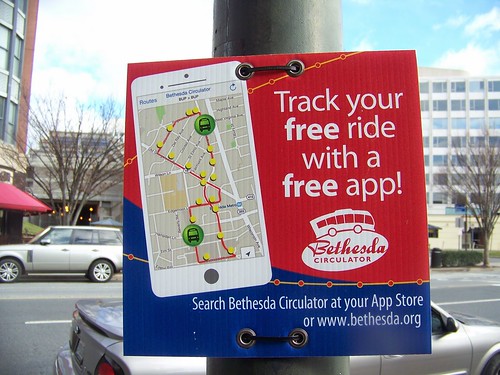
Developers will need to get on board with the concept of "shared parking." One wrinkle is "walk off" parkers--people who park in one shopping center but then go off to another without moving their car.
Ideally, all of the property owners can be made to understand that they need to conceptualize the parking as "shared resources" for the entire commercial district, supported by the PikeRide free transit service, and accept that people will move between destinations without moving their cars.
Marketing, marketing, marketing. To make this work, lots and lots and lots and lots of social marketing interventions will be required. Huge amounts of time and energy will have to be directed to the users/various modes in this corridor, to assist people in making the change.
From a transit industry standpoint, successfully launching and operating this kind of bus service in the suburban context could be as transformational as the White Flint land use changes are to suburban land use paradigms.
That will have to be done here too.
Typically, transit marketing programs in the DC region haven't always been that great. For a service like this to work and become transformational, a great deal of attention to marketing planning and execution will have to be made.
-- "Marketing and Branding for Bus Rapid Transit ," Urban Transportation Showcase Program, Government of Canada
-- "Creating and executing the York Region Transit 2002 Marketing Plan," Interkom (I need to track down the actual document)
-- From Here to There: A Creative Guide to Making Public Transport the Way to Go, World Resources Institute
-- "Orange County Ride the Bus campaign," Celtis Ventures Inc.
-- PikeRide: Creating a successful product image, WMATA
-- "Branding Albuquerque Rapid Transit," Studio Hill Design Ltd.
Labels: bus transit, car culture and automobility, parking and curbside management, transit planning, transportation demand management, transportation management districts










6 Comments:
Richard,
I like this idea a lot; I try to avoid Rockville Pike if at all possible to avoid the dismal getting in and out of parking lots into the traffic to get from one shopping center to another. You did include a few sentences about walk-off parking (I don't want to go across the street and find my car towed), but I think this is a really big thing. This is especially true since I'd expect a large percentage of people to get there by car from somewhere in the region rather than by transit. I think it'll be a big change in thinking to get the shopping center owners to keep their lots captive to their own centers, even if allowing walk-offs might actually increase the number of patrons.
The transit would need to be frequent enough for shoppers to also change their thinking, that they don't need to drive to each and every destination. Were the county to get involved in this type of transit (and they should!), I think they'd need to somehow reward developers to buy into this vision, including pushing their retail closer to the road with parking lots behind, instead of people needing to walk past a sea of parking to get to the stores.
To be honest, the walk-off issue I think is a big drawback to small retail areas. You've written about this in re Takoma, and I think your Silver Spring ideas (Fenton as a Signature Street and the transportation district) is hindered by owners' and shoppers' mindset of needing to park right in front of each and every destination. But, I also have Long Branch (Piney Branch-Flower Ave) in mind. If I want to go to Chicken Loco, Ocean City Seafood, and the county liquor store, if I can't find one of the few on-street spots, I need to park in three different places that are maybe 500 feet apart.
Also, would you mind posting in comments a link to the post where you described the Signature Street concept for Fenton Street? I was recently looking for it but had trouble finding it among your many posts on Silver Spring.
I am about to write about Long Branch-Takoma Crossroads-Langley in a transformative way, but not at the same level of detail comparable to the Silver Spring series, but in a continuation of the Purple Line writings.
Was at a workshop last week about it. Still need to send follow up to MC Parks people, who were the leads. (Wow, that department has really really really able and skilled people. I was so impressed.)
wrt "Signature Streets and Fenton" in writing it's an example of "burying the lede" as it is the first few items with the 18! point program.
http://urbanplacesandspaces.blogspot.com/2017/06/pl-5-creating-silver-spring-sustainable_9.html
Note that in the update piece I intend to write about Silver Spring, one missed idea (not from me, from a MC Planning person) was pedestrianizing (+ transit) Fenton from Colesville to Wayne as a start. The other missed points -- my piece on extending Downtown SS as a retail focused center, the need for in-town playgrounds to extend the ability to serve children, and a point people are making about better connection from the Metro Platform to the street without going to the ground floor of the station.
walk off is tough. The only place that deals with it is College Park. The property owners ceded management of the the private parking and conversion to "public parking" to bring enforcement power vis a vis student parking.
To some extent, the parking foundation in the Chestnut Hill commercial district in Philadelphia is another example.
====
My original signature street proposal in Baltimore County included flipping the development paradigm, with parking in back, and not criticizing the automobile orientation of the retail otherwise.
Not saying it will be easy.
I think anything transformative for Takoma Langley/Long Branch, in any detail, would be great: how to manage things where we capitalize on the public investment (Purple Line) but also maintain the local small businesses. Honestly, that area needs parking/transportation districts.
Perhaps Montgomery County needs to talk to College Park officials.
The pedestrianizing of Fenton from Wayne to Colesville intrigues, especially anchored on the south by the library Purple Line station.
Finally, in re parking in the back, I think that needs to complement PikeRide. Developer incentives will be needed.
And, yeah, none of this will be easy. Including getting shoppers/visitors to move from a mindset of driving to each individual establishment to a park-and-walk mentality. Even in re Fenton Street, I'd be in favor of county buyouts of small development applications that have gone nowhere on small lots to some sort of parking. Park one time and walk to shopping and restaurants.
In the Silver Spring series, point #5 is about parking, although focused on the public parking, with integrated valet and potentially a little electric shuttle on Fenton.
The tough thing with the PikeRide idea is the distance from the street front to the interior of a shopping center ("where the stores are"). They may need "Fred-lite" e-vehicles too.
The other thing I was thinking is that a couple of the cross streets might need a complementary service too. Like Nicholson Lane.
======
Saving the small businesses requires another type of program. As the sites are rebuilt the retail space becomes repriced upward, significantly.
There should be a retail support program for independent businesses with rent support.
The businesses that are there now, it's classic Jane Jacobs. In buildings that are old, paid off, with low rents, and/or in lower demand.
In the article in the Post a couple days ago about "Asian restauranteurs" and doing oral histories with them, there was a comment by the chef Edward Lee about how as rents increase and areas "upscale" (I don't like the word gentrify in this context, but that's me) the opportunity for mom and pop Asians to create restaurants decline.
It's the same general point.
And true in Takoma-Langley-Long Branch too.
It's important because it's a key element of the uniqueness, identity, and is truly community- and neighborhood-serving.
====
c. 2001-2003, when I first got into this, a UMD arch. school studio did a project on the small businesses in Silver Spring, in the Georgia/Fenton area, and how to preserve them. It'd be marginally interesting in trying to track the document down. It would probably say the same things.
Post a Comment
<< Home